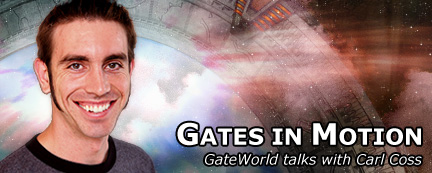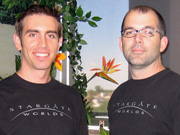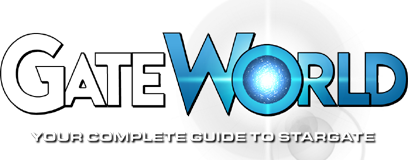
GateWorld: Had you seen Stargate before coming here?
CC: I’d seen the movie. I saw it in the theater and I owned the DVD and loved it. I’m a big Kurt Russell fan. I did like the movie a lot. I don’t watch a lot of TV. When I saw the show I would see clips of it or a friend watching, I was like “Ah, you know, a typical TV show …” So I wasn’t too into it. But interestingly enough, as soon as I got the job I was pretty excited to watch ’em.
GW: You had a reason to watch ’em!
CC: Yeah! And I wanted to know, too, because I wanted to be able to chat with people about it. And of course I should know, because I’m doing the animation for the game! So I started watching ’em. It didn’t take long to really get into it. It’s actually really well done. For all their production/budget deficits in the beginning, it’s gotten really cool. The whole overall story arc is pretty epic, and I do like that. I think disconnected from the TV without the commercials and stuff — I’ve been watching it on DVD, just in one sitting — so it’s more like a movie to me, and I think it helps too. I love it. And I’m watching Atlantis. So it’s really exciting.

Coss formerly worked with friend and art director Howard Lyon at a small software company, Professor Fog’s Workshop.
GW: What does your job involve on a day-in, day-out basis? You’re also a manager.
CC: It depends on the day, yeah. There’s a lot of meetings. I have to keep my animators busy and give them work. A lot of scheduling and meetings. I do like to do some animation myself if I can! I love to do it all the time.
At the same time it’s really fun to be involved in all the management stuff and help direct the schedule so we can be on time for things and avoid working crazy hours, and then also to have a say in how it feels and be involved in those decision-making meetings, and be able to come up with the style of animation, how we’re going to animate things like the Asgard and really how I think they should be, and present that and get the feedback from what everyone else thinks.
But day to day, there’s as few scheduling meetings. We might have a meeting to decide something about the animation system, or the engineers need assistance to format our animations in a different way. Something like “Where are we going to keep the weapons? Are they stored on people’s backs? In bags?” That kind of thing.
There’s tons of decisions like that that go into all this stuff, and the animation system has to be pretty laid out. Like I said, for one movement for a walk cycle there’s 30 or 40 animations that are based on that. So if you change something down the road you’re changing hundreds of animations, and possibly your animation system.
So it’s been an exciting challenge to come in here and start locking all that stuff down to get a more solid idea of everything we’re going to need, so that way when unknowns do pop up they’re not mind-shattering. Or world-shattering.
GW: One of the things that irritate me a little bit, being a World of Warcraft player myself: I’ll stop in the middle of a territory and watch an NPC walk around. Let’s take an alligator, for instance, like in Loch Modan. He’s walking in one direction, and then he stops, and then he turns around instantly —
CC: — pops, yeah —
GW: — and walks the other way. Now, are we working to prevent that in our game?
CC: Well, where we can. One of the things I’ve seen in a lot of MMOs is there’s a little less attention to detail because there’s so much quantity. And that’s definitely a challenge for us, too. But there’s a lot of places you can hedge that back a little bit. So in an instance like that you might see that in our game. If we have 75 monsters to do, or more, and there’s a limited amount of time. You’re talking thousands of animations. You just can’t have fill-in-little-gap animations for all of them like that.
But we can do things like make sure they have a turn or slide around or where a character’s behavior will actually prevent it from actually flipping around all the way. Or, when you see characters that do things all the time — the characters you see more and more basically will hopefully have less of that. We’ll prioritize things as a percentage — how often will you see this, how big of a part of the game will it be [in] — and we’ll flesh things out more that you’ll see more often.
With the player characters we’re trying to fill in most of that stuff, so they look really solid all the time.
GW: Yeah, I’ve seen some of your stuff. It already looks pretty stable. We’re still a ways away.
CC: Yeah! It’s going to be really telling when we see these things really working all the way in the game. There’s going to be a lot of tweaking. But it’s exciting to be getting stuff in there and start being able to work on that.
GW: Have any of your animations actually been applied to any of the realms yet?

A wire-frame mesh of a Stargate Worlds character
CC: Yeah, you can run around as a couple of different characters. Some of the blending is not working, but we’ve started to see things in the game and put one or two of the monsters in there. But you can’t actually play it yet. You can run around. So you can’t see everything for sure. It’s nice to see stuff in there.
But it’s definitely apparent seeing things in the game is super important. Once you see things in the game there’s stuff you want to change to make it look better. And a lot of stuff you can’t actually say is 100 percent done until you see it in the game. And then you know, “OK, well I need to do this or this.” Pull it back and then it can look really good.
GW: So you have to play it a lot.
CC: Well not necessarily play it, but transition. We’ll watch them run, and then run left, and we’ll watch how their feet go, and mess with the blending with those two animations and how they work together in every way. Standing, crouching, and all the different transitional stuff is what makes it believable.
It’s like you said. When something “pops” like that it instantly pulls you out. So the more transitions, the more real it is. So having those in between working really well, invisible to the player, but just keeping them in the game is ideal. And that’s stuff you can’t really test until you have them all in there working together. Because we do them all separately.
GW: I doubt you’re going to be able to drink a pint and not be able to walk in a straight line in this game.
CC: That’s up to systems! It depends how much you’re going to be able to do! If it’s something that’s a big part of the game —
GW: — but are you prepared to animate, like if someone gets shot with a bullet they limp or cover that section?
CC: As far as the damage goes that’s something that we just don’t know yet. There’s a lot of things that are more important to me before that. Basically it’s a list of priorities. What can we do? What are we going to have time for? What’s important to systems? What’s important to content?

